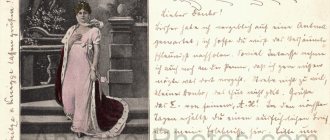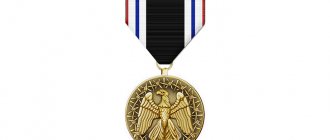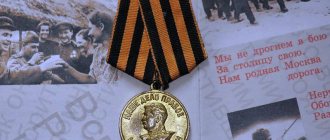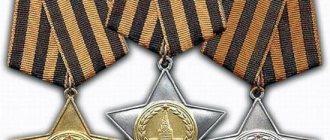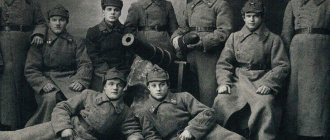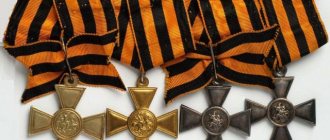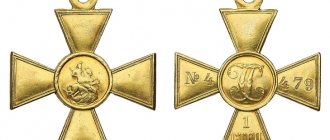12/24/2018 Category: Useful articles
- 2 Appearance
- 3 Degrees of the Order of Suvorov
- 4 History of the order
- 5 Wearing
- 6 Interesting facts
The history of the Russian state is full of great achievements. Since ancient times, Russia has been distinguished by its participation in an endless series of wars. Of course, our great power also had its brilliant commanders. A striking example is Alexander Vasilyevich Suvorov - the great Russian commander, the man who laid the foundations of military theory in Russia and is rightfully considered its hero.
Alexander Vasilievich Suvorov
General information about the award
It was in honor of this outstanding personality that, in view of the decree of the highest bodies of the USSR, the Order of Suvorov was established on July 29, 1942.
In Russia, the order was established in 2010 by decree of the President of the Russian Federation.
To this day, it is awarded to individuals in positions of commanders of formations, their deputies, as well as people who are heads of operational departments, commanders of various branches of the military and special forces.
Below is a list of the reasons on which this award is given.
The Order of Suvorov is awarded when:
- A person in one of the positions listed above was able to organize an operation and lead the troops entrusted to him, any formation or unit, and at the same time coped with the task, despite the fact that the enemy outnumbered him in all known parameters (numbers, weapons, technical equipment.). He also achieved a more advantageous position in the light of military events, or captured a tactically advantageous area and was able to hold it, while taking the initiative upon himself.
- He was able to organize and, in fact, lead any formation that is part of the Armed Forces of the Russian Federation during a defense operation against an enemy trying to show aggression against Russia (as well as parties that are allies of the latter).
- The award is also issued in individual cases when military personnel in one capacity or another have proven themselves in the defense of their homeland, during an operation to ensure a peaceful situation in a particular area, as well as during an operation to destroy terrorist units in any area. Issued regardless of the conditions of the operation (land, air).
The award can be presented to a detachment, unit or unit.
The order is also awarded to military personnel who distinguished themselves but died during the operation. The award is made posthumously.
Order of Suvorov
Why did the order receive the name of the general?
In order to somehow encourage generals to successfully conduct military operations, they decided to change the traditional award system, when almost every person could be awarded any order or medal - from a simple Red Army soldier and a civilian to a marshal. According to the new system, you could receive one or another award if you held a certain position.
At the very beginning of the design, before the Order of Suvorov (WWII) appeared, it was planned to introduce the Order of the Red Banner with crossed swords into circulation. But then they decided to leave the awards with the names of the great Russian commanders, since it became clear that patriotism during the Civil War would not get you far. After all, army traditions are formed not even over years, but over centuries, so we decided to turn to the experience of past times.
Appearance
The first degree of the order is represented by a convex star made of platinum, which has five points. The rays diverge radially on the surface. In the geometric center of the star there is a circle of gold, on which dark gray enamel is applied, as well as a red stripe located in its upper part. The upper ray is distinguished by a small star of the same red color. On the circle, in its upper part, there is a gold inscription consisting of the name and surname of the great commander - Alexander Suvorov. At the bottom, the circle is framed by an oak wreath, which, as expected, has a green tint. Also in the golden circle there is an image of the commander himself.
Awards of the II and III degrees are slightly different from the most important and coveted: platinum was used to produce the order of the first degree, and gold and silver are already used for the second and third.
Also, each of the existing degrees is distinguished by the number of stripes on the ribbon attached to the order.
Order of Suvorov 1st degree
Creation of new battle awards
The above-mentioned orders were established the day after Stalin’s decree “Not a step back,” which indicates the Supreme Commander-in-Chief’s understanding of a simple truth: fighting spirit and patriotism cannot be cultivated through coercion alone; it is necessary to show an example of valor and perseverance, which permeate the entire history of the Russian state.
The Order of Suvorov, along with other new awards, was created by the technical committee of the Red Army with the involvement of the artist Telyatnikov, Dmitriev, who created the Order of Lenin, and other prominent decorators who designed famous military awards, such as the Medal for Courage. This team of artists created 55 different designs for the orders, from which 11 sketches were selected for further work on them.
A student of the architectural institute, P. Skokon, who had already visited the front, was involved in the creation of the Order of Suvorov. It was his copy that became the prototype of the future award. But, on the advice of experts, some changes were added to the front side of the decals. Thus, the Order of Suvorov, 1st class, received a red star over the portrait of the commander, so that it would be different in appearance from the 3rd class award, which had the same color. There were also changes in the dimensions of the orders - they were reduced by 7 mm.
Degrees of the Order of Suvorov
Immediately after approval in 1942, the Order of Suvorov received three known degrees: I, II, and III. The highest degree, accordingly, was the 1st degree of the order.
The 1st degree of the order was awarded to persons in the status of commander of the front, the army as a whole, their deputies could also be awarded this award. This list also included persons in charge of any operational department or military unit for the following merits:
- the operation to eliminate the enemy with superior forces was skillfully organized and successfully carried out;
- the enemy, having a numerical superiority, was surrounded and completely defeated, accompanied by the seizure of weapons, equipment, etc.;
- the initiative was taken in delivering the main blow to the enemy forces, as a result of which a complete victory was won while maintaining the combat effectiveness of the entrusted unit;
- the operation was perfectly hidden, as a result of which the enemy was unable to regroup and, as a result, was destroyed.
The II degree of the order was awarded to persons who command corps, any division or brigade, as well as their deputies, for the following merits:
- the enemy (division or corps) with superior forces was completely neutralized (destroyed) thanks to the coordinated actions of all forces involved;
- enemy defensive ranks (or fortifications) were broken through, as a result of which the operation had a successful outcome;
- a way out of the encirclement situation was achieved with full preservation of the group’s combat capability, as well as the entrusted technical means and weapons;
- An operation was carried out deep behind enemy lines, during which he slowed down his pressure, or was completely defeated.
The III degree of the order is awarded to commanders of regiments, battalions and chiefs of staff of regiments. The Decree of the Presidium of the Supreme Soviet of the USSR dated February 8, 1943 (Article 4) established that this order can also be awarded to company commanders: for competent organization of battle and demonstrated initiative in conducting a swift and bold attack of superior enemy formations and their destruction.
Degrees of the Order of Suvorov
What orders was awarded to Suvorov?
Alexander Vasilyevich Suvorov is a genius of military affairs; he has won many battles and battles, moreover, in conditions of a minority of armed forces. And, like every man of genius, Suvorov had his own quirks - he was very fond of awards, and selectively - only for military operations and battles. Suvorov considered awards for various displays of maneuvers and parades an insult. Thus, he has not only all domestic insignia, but also many foreign ones. When the insignia corresponding to his status and the importance of his actions ended, the government awarded Alexander Vasilyevich with personalized weapons, other similar items, or orders, encrusted with diamonds and other jewelry.
History of the order
This award is rightfully considered the first to have several degrees during the Soviet era. The order was considered superior to all existing awards of this type. Simultaneously with the Order of Suvorov, two more orders were established, which were named in honor of two more great Russian commanders: Mikhail Kutuzov and Alexander Nevsky. The first was distinguished by the presence of only two honorary degrees, and the second had only one.
Military leaders were honored to wear the Order of Suvorov on their chests exclusively for special merits, so the award is distinguished by its “offensive” character. This also proves her status. There have been cases where commanders of a unit were awarded the Order of Suvorov, when at the same time his deputy could receive the Order of Kutuzov of the same degree. For example, an illustrative case from history: Colonel General Petrov I.E., the commander of the Northern Caucasian Front during the Second World War, completely cleared the Kuban and Taman Peninsula of fascist invaders (October, 1943), for which he was honored to receive the title general of the army and wear an honorary award named after Suvorov (1st degree) on his chest. At the same time, the chief of staff on the front of the same name, Major General Laskin I. And during the same operation, he received the rank of lieutenant general and was honored to wear an order on his chest, only named after Kutuzov, but still of the same 1st degree.
The author of the project to create an award in honor of Suvorov is the architect Pyotr Skokan. The selection committee gave the go-ahead for the publication of the order in 1942 (July 21). It was at this time that fierce battles took place near the Don and Volga, where Russian troops were thrown back under the endlessly strong onslaught of German formations. It was then that the order was established, when there were no surviving buildings left on Sevastopol soil, and the famous slogan was established with just 3 words: “Not a step back!” The leadership hoped for the stamina and courage of its soldiers and commanders, and, accordingly, they needed to be encouraged in such a difficult time for any successes in resistance and defense of objects strategically important for the state, as well as for active offensive actions.
Order of Alexander Suvorov
According to the original idea, the new highest award could be received only if the person was in the appropriate position. A preliminary decision was made to renounce the old canons of the USSR, when any soldier who was part of the Red Army could be awarded an award of any importance, regardless of what rank he had or what status he was in.
The first recipient of the order named after the great commander was Marshal G.K. Zhukov, and then other military leaders with ranks from army general to lieutenant general were also awarded this award.
For the first time in history, the Order of the Great Commander, second degree, was received by V. M. Badanov for being able to strike one of the most important strategic points for Paulus’s army - the airfield near the Tatsinskaya station. It was with its help that German troops delivered all the necessary supplies for the detachments that were surrounded in the Stalingrad area.
The third degree was first received by Major Z. N. Garanin (February 3, 1943). The reason for this was the skillful application of all the knowledge gained regarding combat tactics, due to which the Nazi invaders suffered serious damage.
Presentation of the first degree insignia
The order of this degree was first awarded to marshals and generals who distinguished themselves in the battles of Stalingrad and Leningrad in January 1943. Among the twenty-three awarded were such famous military leaders as Marshal G. Zhukov, artillery commander N. Voronov, Headquarters representative A. Vasilevsky, front commanders N. Vatutin, K. Moskalenko, V. Chuikov and other outstanding commanders of that time.
Also, this high award was awarded to the Frunze Military Academy and the Military Academy of the General Staff, and Stalin also had it.
Wearing
This award is attached to the left side of the chest. If there are other orders (named after Nevsky, for example), then the Order of Suvorov is located strictly to the right of it. In certain periods, the Order of Friendship was replaced by the Order of Alexander Nevsky.
A copy of the order itself (in miniature) is also provided, which inherits all the rules of wearing from the senior badge.
When an award is presented to a unit, all distinctive attributes are attached to the Battle Banner.
Wearing the order
Heroes who received the 3rd degree award
Awarded the Order of the 3rd degree: the first person to receive this insignia was Major Garanin at the beginning of 1943. In total, the order of this degree was awarded to 391 people, among them 20 commanders were honored to receive the award three times.
The Order of the 3rd degree was awarded more than 4,000 times, including 849 to combat units and subunits.
In total, the Suvorov Order was awarded 7,266 times, including 1,528 to combat units, and more than 80 times to generals and officers of various branches of the military. Also among the holders of the Order of Suvorov is the commander of the French military formations, General Georges Delattre de Tassigny, who received the 1st degree insignia in the summer of 1945.
Award after the Great Patriotic War
After the end of the Patriotic War, there was no mass presentation of the Order of Suvorov. The only cases are the presentation of awards for “international missions”.
But the story of the Order of Suvorov does not end there. To date, this insignia is still present in government awards of the Russian Federation, only externally it has undergone some changes.
Now the Russian Order of Suvorov is made in the form of a straight four-pointed gilded cross (like the Maltese). Between the wide rays there are narrow silver ones. In the center of the cross there is a silver medallion, which depicts the gilded profile of Alexander Suvorov. Under the portrait there are crossed laurel and oak branches entwined with a ribbon. Along the circle of the award there is an inscription with the name of the commander, made in red enamel.
In modern Russia, the awarding of the Order of Suvorov occurs according to the same principles as during the Patriotic War, only now the award is given to commanders and soldiers of the ground forces, which is natural, since Suvorov was a “people’s” commander who shared all the hardships of military life along with ordinary soldiers . But the abolition of the 1st and 2nd degrees of this order is a mistake.


